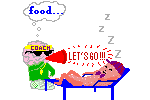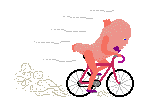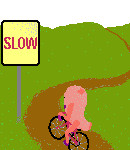VIVO Pathophysiology
One Meal in the Life of the Stomach
The stomach functions dynamically, in parallel with meals. Consider the stomach's most notable activity - secretion of acid. Acid is secreted in large quantities when the stomach is distended with food, which is useful because it facilitates the initial breakdown of proteins. However, once the meal has been liquefied and the stomach has emptied, acid secretion trickles to a stop and remains shut off during the interdigestive period. This shut-off in acid secretion is a good thing - otherwise excessive acid would damage the mucosa of the stomach and small intestine, as happens in certain disease states.
Gastric function is often classified into three phases in which secretory and motor activities are tightly coupled. Try identifying these phases in yourself or your loved ones around meal time:
 |
Cephalic phase ("wake up call"): Seeing, smelling and anticipating food is perceived in the brain and the brain informs the stomach that it should prepare for receipt of a meal. This communication is composed of parasympathetic stimuli transmitted through the vagus nerve to the enteric nervous system, resulting in release of acetylcholine in the vicinity of G cells and parietal cells. Binding of acetylcholine to its receptor on G cells induces secretion of the hormone gastrin, which, in concert with acetylcholine and histamine, stimulates parietal cells to secrete small amounts of acid. Additionally, a low level of gastric motility is induced. In essense, the gastric motor is turned on and begins to idle. |
 |
Gastric phase ("full steam ahead"): When a meal enters the stomach several additional factors come into play, foremost among them distension and mucosal irritation. Distension excites stretch receptors and irritation activates chemoreceptors in the mucosa. These events are sensed by enteric neurons, which secrete additional acetylcholine, further stimulating both G cells and parietal cells; gastrin from the G cells feeds back to the parietal cells, stimulating it even further. Additionally, activation of the enteric nervous system and release of gastrin cause vigorous smooth muscle contractions. The net result is that secretory and motor functions of the stomach are fully turned on - lots of acid and pepsinogen are secreted, pepsinogen is converted into pepsin and vigorous grinding and mixing contractions take place. However, there is a mechanism in place in the stomach to prevent excessive acid secretion - if lumenal pH drops low enough (less than about 2), motility and secretion are temporarily suspended. |
 |
Intestinal phase ("step on the brakes"): As food is liquefied in the stomach, it is emptied into the small intestine. Its seems to be important for the small intestine to be able to slow down gastric emptying, probably to allow it time to neutralize the acid and efficiently absorb incoming nutrients. Hence, this phase of gastric function is dominated by the small intestine sending inhibitory signals to the stomach to slow secretion and motility. Two types of signals are used: nervous and endocrine. Distension of the small intestine, as well as chemical and osmotic irritation of the mucosa is transduced into gastric-inhibitory impulses in the enteric nervous system - this nervous pathway is called the enterogastric reflex. Secondly, enteric hormones such as cholecystokinin and secretin are released from cells in the small intestine and contribute to suppression of gastric activity. Collectively, enteric hormones and the enterogastric reflex put a strong brake on gastric secretion and motility. As the ingesta in the small intestine is processed, these stimuli diminish, the damper on the stomach is released, and its secretory and motor activities resume. |
To summarize, the brain alerts the stomach that it should expect arrival of a meal and the stomach comes out of its interdigestive quiescence and begins low level motor and secretory activity (cephalic phase). After a meal is consumed, the gastric motor and secretory activity is fully turned on (gastric phase). If the meal is at all substantial, the gastric phase is periodically suppressed by signals from the small intestine and, if gastric pH falls to very low levels, from the stomach itself. Eventually, the meal is fully liquefied and emptied, and the stomach falls back into a state of very low motor and secretory activity, where it remains until the next cephalic phase.

